Build Size, Strength and Speed with This 4-Week Rugby Workout Programme

Both mentally and physically, elite rugby players hit different. For 80-plus minutes they’re expected to absorb high-velocity collisions that would dispatch most family hatchbacks to the scrapheap, then run through proverbial brick walls for king and country. Again. And again. And again. Endurance is their super strength – and that’s well earned, thanks to hours spent reinforcing their foundations in the gym.
Those fundamentals are essential for any rugby player, but they hold a huge caché for anyone looking to smoke a Hyrox, crush a CrossFit comp or simply add a few extra plates to their weight stack.
Meet the Expert: Tom Tombleson knows what it takes to get rugby fit better than most. A former pro with Northampton Saints and England Sevens, the S&C coach has spent over a decade developing the hearts, minds and muscles of the senior England men’s side.
‘Speed kills and power is a big premium,’ Tombleson tells Men’s Health. ‘At the national level, rugby players need to be explosive and dynamic. Whether that’s big guys, lean guys, fast guys or not so fast guys.’ Whatever your build, he says, there are some vital lessons everyone should take from a rugby player’s playbook – starting with how to R&R like a test-match animal.
‘There’s only so much of a hole you can dig with the human body,’ Tombleson says, in terms of how hard you should thrash yourself in the weights room. In recent seasons, there’s been a drive to address the ‘top six inches’ and help the players psychologically restore and regenerate because, he adds, ‘where the mind is willing the body will go’.
With the national side, this has included a lot of ‘non-sleep deep rest’ – recovery protocols made fashionable by the likes of author Tim Ferriss and neuroscientist Andrew Huberman. ‘We encourage the players to engage in breathwork, to disconnect from their phones and to get out in the elements,’ Tombleson explains.
That said, it’s not all brains over brawn. The weights room is still the rugby player’s sanctuary. In the gym, Tombleson says, a typical programme is built around the nuts and bolts of full-body, sport-specific exercises. ‘We like to train movements not muscles,’ he says. ‘This helps consolidate stress by sharing it across the body.’
Sessions never last more than an hour, tending to start with a low-rep, dynamic lift like jump squats or cleans, followed by big compound exercises including squats, deadlifts, landmine presses and prone rows. At least one routine will include core- and hip-focused accessory work, the other sprinkling in a high-volume bodybuilding component to maintain shock-absorbing muscle mass.
Then, to keep his players’ engines running, Tombleson likes to include drills that train aerobic and anaerobic energy systems with short, sharp blasts on the assault bike that simulate the average ball-in-play time of four minutes.
The 4-Week Rugby Strength and Conditioning Plan
Space out these workouts across your week and repeat them for a month.
Workout 1: Explosive Strength + Core Stability
Big lifts are a rugby player’s bread and butter, but accessory exercises are just as vital to avoid injury. ‘For the power clean, use a load that allows for fast, snappy reps,’ says Tombleson. Remember: power is the name of the game.

1. Power Clean
Build up to 4 sets of 3 reps
Hinge down and grip your barbell with your back flat, torso upright. Explosively stand up, shrug your shoulders and use momentum to pull the barbell up while quickly dropping beneath it. Catch the bar on your shoulders with a slight bend in your knees. Stand up, lower the bar under control and repeat.

2. Barbell Back Squat
Build up to 3 sets of descending reps: first 7, then 5, then 3
With your feet at shoulder width, secure a barbell across the top of your shoulders. Maintain an upright torso and push your hips back, bending your knees until the crease of your hips drops below your knees. Stand back up explosively, take a breath and repeat.

3A. Landmine Press
3 sets of 8 reps each side
Secure one end of the bar, grip the loaded end and clean it up on to one shoulder. Lunge backwards with the opposite leg to finish in a tall kneeling position. Brace to create tension, then push the barbell away from your shoulder explosively. Pause at the top, slowly lower to your shoulder and repeat.

3B. Single-Arm Row
3 sets of 8 reps each side
Perform standing, hinging forwards with a flat back, or place one knee and hand on a bench for support. With the dumbbell hanging at your side, row it up towards your hip, keeping your arm close to your body throughout. Squeeze at the top, then lower under control before repeating.
Core circuit
Round off Workout #1 by using this core- and hip-focused giant set to build serious staying power. Perform each move in turn for 30 secs, then go back to the start for 3 rounds in total. Swap out for easier plank variations if you’re struggling.

4A. Copenhagen Plank
Set up for a side plank with your top foot on an elevated surface. Keep your legs straight and ankles, hips and shoulders aligned.
4B. Single-Leg Hip Thrust
Lie back with your heels flat and knees bent. Straighten one leg, then drive your hips high. Lower slowly to tap the floor, then repeat.
4C. Side Plank Leg Raise
Lie on your side with your feet stacked, supporting your weight with your forearm. Raise the top leg and hold it there.
4D. Three-Point Plank
Perform a plank with your weight resting on your forearms and lift one foot, keeping your hips still. Hold for 30 secs, then switch legs.
Workout 2: Aerobic Conditioning
Tombleson prefers to keep his players’ conditioning sessions ‘off feet’ to allow their joints time to rejuvenate. ‘Given a choice, I’d always opt for the assault bike,’ he says. ‘It uses more muscle mass, and the more muscles that you work, the bigger the hit on your heart and lungs.’
Assault Bike Intervals
Complete 6 sets of 2 mins on, 1 min off
‘Don’t worry too much about calories burned or distance covered,’ Tombleson adds. ‘Heart rate impact is more important.’ Instead, aim to maintain an 8/10 on the rate of perceived exertion (RPE) scale.
Workout 3: Explosive Strength + Bodybuilding
Body-part split training might be redundant for modern pros, but muscle-growing hypertrophy protocols – like this 4-move accessory giant set (4A to 4D) – will always have their place. Muscle, after all, is a rugby player’s body armour.

1. Barbell Jump Squat
Build up to 5 sets of 2 reps
Don’t go too heavy with this one. Secure a barbell across your shoulders and drop down into a squat, just breaking parallel. Explosively jump upwards as high as possible, then land with soft knees and sink straight back into the squat, ready to repeat. Switch to dumbbells if you don’t have access to a bar.

2A. Dumbbell Box Step-Up
4 sets of 10 reps each side
Stand in front of a box, weights hanging at your sides. Step one foot up on top and drive your foot into the box. Bring the other foot up alongside it and finish standing tall. Step back down, one foot at a time, switch legs and repeat.
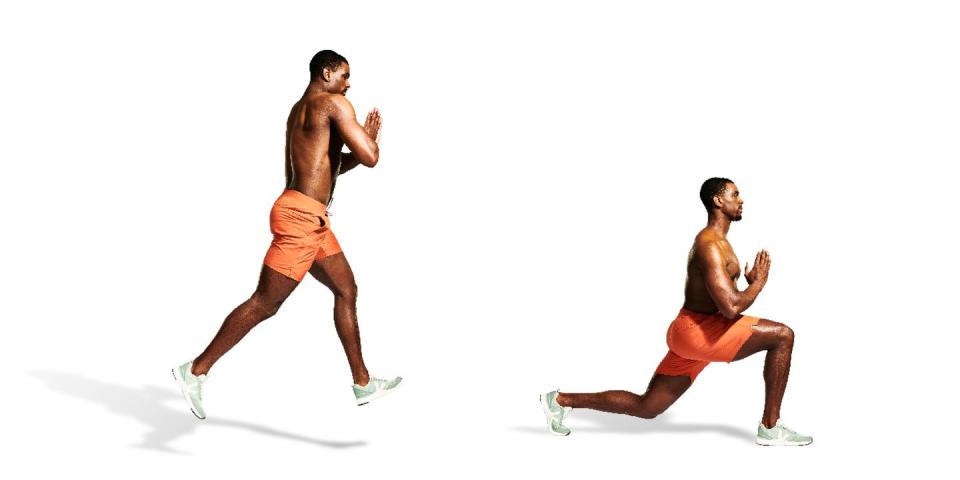
2B. Split Squat Jump
4 sets of 2 explosive reps each side
Step one foot back and sink into a deep lunge, with your rear knee lightly touching the floor. Explode upwards into a jump, switching legs mid-air to land in a lunge position with the opposite leg forwards. Repeat the movement, alternating legs each rep and aiming to jump as high as possible.

3A. Dumbbell Bench Press
4 sets of 6 reps
Lie flat on a bench, your knees bent. Press the dumbbells up, locking out your elbows, then lower them slowly to your chest, keeping your elbows at a 45-degree angle. Pause before explosively pressing back up. Squeeze your empty fist to create tension.
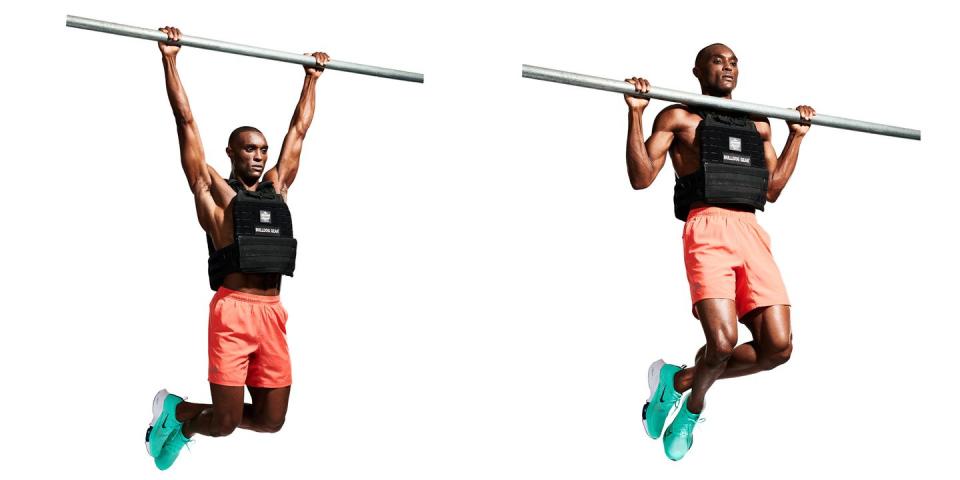
3B. Weighted Pull-up
4 sets of 6 reps
Strap on a weighted vest or belt. Grab the bar with an overhand grip, hands slightly past shoulder width. Lift your feet from the ground, then pull yourself up by flexing your elbows and pulling your shoulder blades down and back. Pause when your chin passes the bar, then lower slowly back to the start.
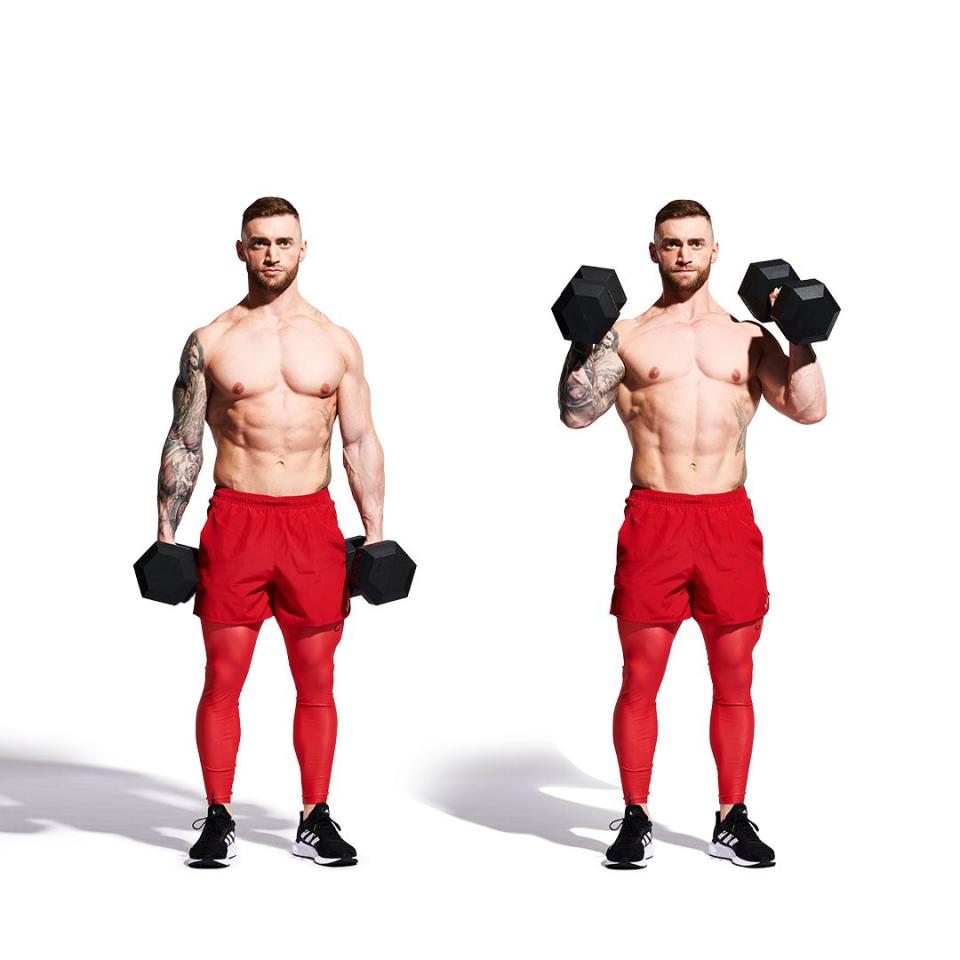
4A. Dumbbell Hammer Curl to Press
3 sets of reps to near failure
Stand tall holding a pair of dumbbells at your sides. With minimal momentum, keeping your upper arms tight to your body, curl the dumbbells upwards, keeping your palms facing each other. Now press the ’bells overhead. Lower the weights back down to your sides, then repeat.
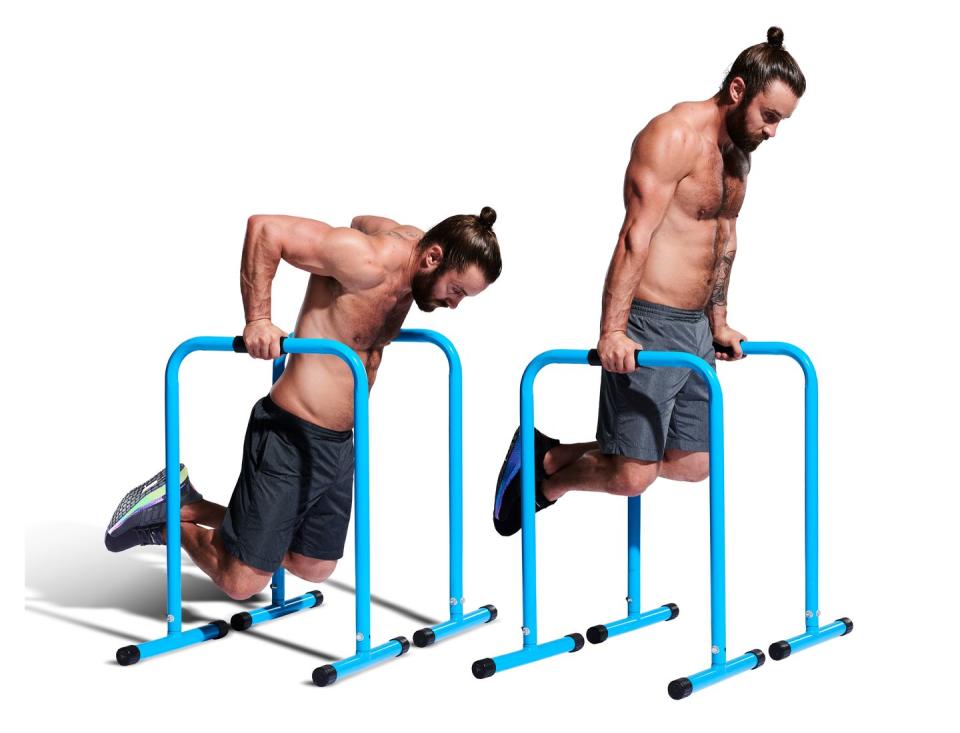
4B. Dips
3 sets of reps to near failure
Jump up on two parallel bars or set up in the dip machine, palms facing inwards and your arms locked out straight. Lean forwards and bend at the elbows, slowly lowering your body until you feel a deep stretch in your chest. Pause here before explosively driving yourself back up to the top.

4C. Dumbbell Lateral Raise
3 sets of reps to near failure
Stand tall holding a pair of dumbbells at your sides. Without using momentum from your hips, raise both arms up, straight, either side of your body until they’re parallel to the ground. Pause here for a beat before slowly lowering the dumbbells under control to your sides.

4D. Dumbbell Upright Row
3 sets of reps to near failure
Stand tall holding your dumbbells by your sides. Keeping your core tight and torso steady, pull the weights up towards your chin, driving your elbows up and back. Slowly lower back down to the start position under control, then repeat. Avoid excessive movement in your torso.
Workout 4: Anaerobic Conditioning
The average ball-in-play time in pro rugby is around four minutes, so Tombleson reflects this with blasts on the assault bike or Wattbike. ‘Try for max calories per six-second effort to give you something to aim for.’
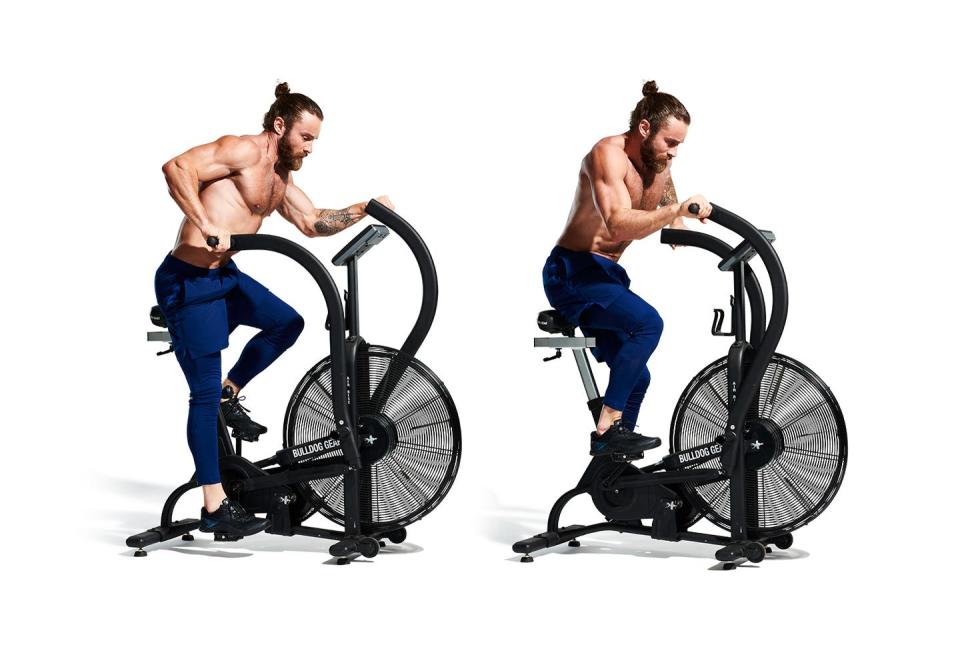
Assault Bike or Wattbike Intervals
Complete 6 sets of 6-sec sprints every 20 to 30 secs for 4 mins, then rest for 2 mins and repeat for 3 rounds in total
Active Recovery
Between each round, perform 2 mins of active recovery using actions that target muscle groups that haven’t been worked on the bike, such as light footwork drills, lateral steps, passing, kicking or hitting a heavy bag. ‘Whatever it is, keep your body moving,’ says Tombleson.
You Might Also Like


